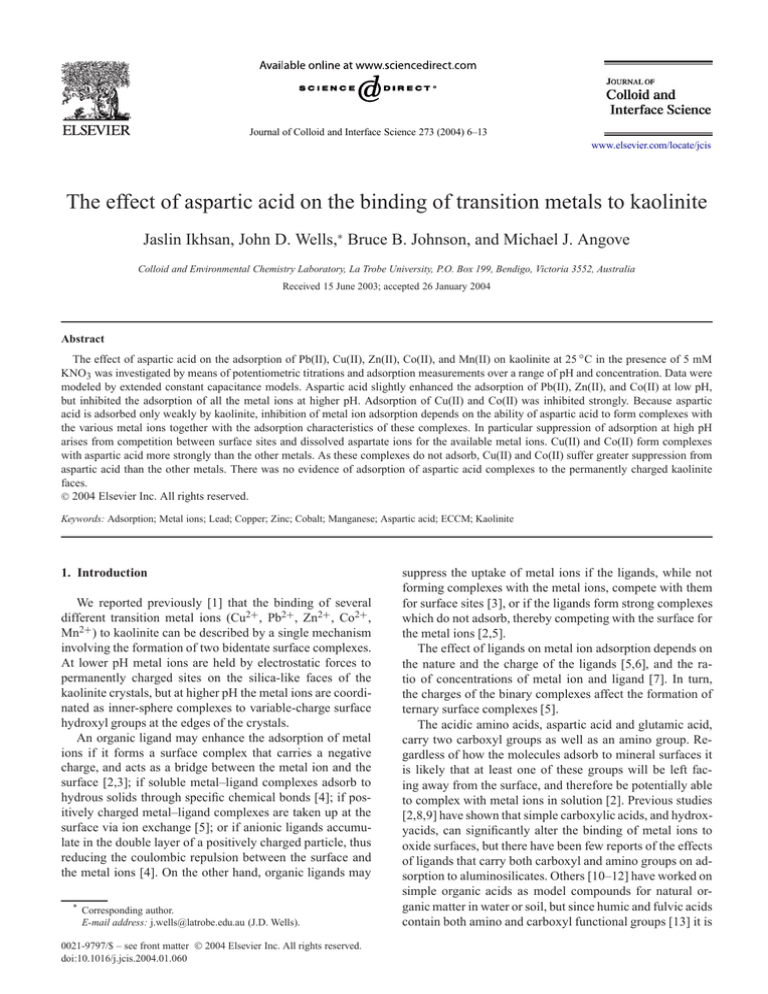
Journal of Colloid and Interface Science 273 (2004) 6–13
www.elsevier.com/locate/jcis
The effect of aspartic acid on the binding of transition metals to kaolinite
Jaslin Ikhsan, John D. Wells,∗ Bruce B. Johnson, and Michael J. Angove
Colloid and Environmental Chemistry Laboratory, La Trobe University, P.O. Box 199, Bendigo, Victoria 3552, Australia
Received 15 June 2003; accepted 26 January 2004
Abstract
The effect of aspartic acid on the adsorption of Pb(II), Cu(II), Zn(II), Co(II), and Mn(II) on kaolinite at 25 ◦ C in the presence of 5 mM
KNO3 was investigated by means of potentiometric titrations and adsorption measurements over a range of pH and concentration. Data were
modeled by extended constant capacitance models. Aspartic acid slightly enhanced the adsorption of Pb(II), Zn(II), and Co(II) at low pH,
but inhibited the adsorption of all the metal ions at higher pH. Adsorption of Cu(II) and Co(II) was inhibited strongly. Because aspartic
acid is adsorbed only weakly by kaolinite, inhibition of metal ion adsorption depends on the ability of aspartic acid to form complexes with
the various metal ions together with the adsorption characteristics of these complexes. In particular suppression of adsorption at high pH
arises from competition between surface sites and dissolved aspartate ions for the available metal ions. Cu(II) and Co(II) form complexes
with aspartic acid more strongly than the other metals. As these complexes do not adsorb, Cu(II) and Co(II) suffer greater suppression from
aspartic acid than the other metals. There was no evidence of adsorption of aspartic acid complexes to the permanently charged kaolinite
faces.
2004 Elsevier Inc. All rights reserved.
Keywords: Adsorption; Metal ions; Lead; Copper; Zinc; Cobalt; Manganese; Aspartic acid; ECCM; Kaolinite
1. Introduction
We reported previously [1] that the binding of several
different transition metal ions (Cu2+ , Pb2+ , Zn2+ , Co2+ ,
Mn2+ ) to kaolinite can be described by a single mechanism
involving the formation of two bidentate surface complexes.
At lower pH metal ions are held by electrostatic forces to
permanently charged sites on the silica-like faces of the
kaolinite crystals, but at higher pH the metal ions are coordinated as inner-sphere complexes to variable-charge surface
hydroxyl groups at the edges of the crystals.
An organic ligand may enhance the adsorption of metal
ions if it forms a surface complex that carries a negative
charge, and acts as a bridge between the metal ion and the
surface [2,3]; if soluble metal–ligand complexes adsorb to
hydrous solids through specific chemical bonds [4]; if positively charged metal–ligand complexes are taken up at the
surface via ion exchange [5]; or if anionic ligands accumulate in the double layer of a positively charged particle, thus
reducing the coulombic repulsion between the surface and
the metal ions [4]. On the other hand, organic ligands may
* Corresponding author.
E-mail address: j.wells@latrobe.edu.au (J.D. Wells).
0021-9797/$ – see front matter 2004 Elsevier Inc. All rights reserved.
doi:10.1016/j.jcis.2004.01.060
suppress the uptake of metal ions if the ligands, while not
forming complexes with the metal ions, compete with them
for surface sites [3], or if the ligands form strong complexes
which do not adsorb, thereby competing with the surface for
the metal ions [2,5].
The effect of ligands on metal ion adsorption depends on
the nature and the charge of the ligands [5,6], and the ratio of concentrations of metal ion and ligand [7]. In turn,
the charges of the binary complexes affect the formation of
ternary surface complexes [5].
The acidic amino acids, aspartic acid and glutamic acid,
carry two carboxyl groups as well as an amino group. Regardless of how the molecules adsorb to mineral surfaces it
is likely that at least one of these groups will be left facing away from the surface, and therefore be potentially able
to complex with metal ions in solution [2]. Previous studies
[2,8,9] have shown that simple carboxylic acids, and hydroxyacids, can significantly alter the binding of metal ions to
oxide surfaces, but there have been few reports of the effects
of ligands that carry both carboxyl and amino groups on adsorption to aluminosilicates. Others [10–12] have worked on
simple organic acids as model compounds for natural organic matter in water or soil, but since humic and fulvic acids
contain both amino and carboxyl functional groups [13] it is







